
Winter 2017 issue of Florida Golf Magazine features "The Florida Golf Architecture of Arthur Hills" Click here to read it.

Written by Golf Course Designer, Pete Dye for Florida Golf Magazine
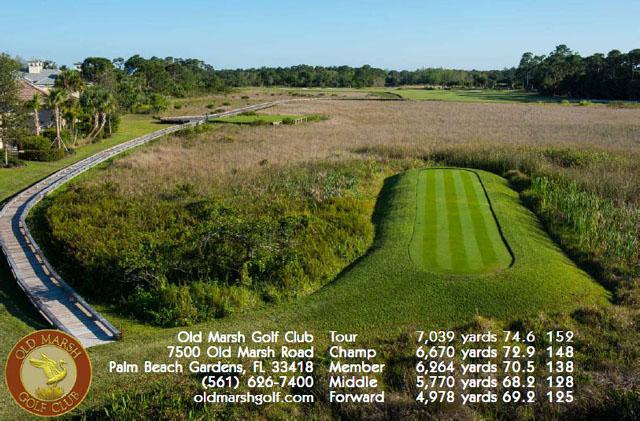 78 yards shorter than the tour players' tee, the 393 yard Championship tee of the par four 15th hole at Old Marsh is still breathtaking.
78 yards shorter than the tour players' tee, the 393 yard Championship tee of the par four 15th hole at Old Marsh is still breathtaking.
|
Old Marsh Golf Club Course Designer: Pete Dye, 1986 18 Holes, Par 72 |
||
|
Tees: Tour Champ Member Middle Forward |
Yards: 7,039 6,670 6,264 5,770 4,978 |
Rating / Slope 74.6 / 152 72.9 / 148 70.5 / 138 68.2 / 128 69.2 / 125 |

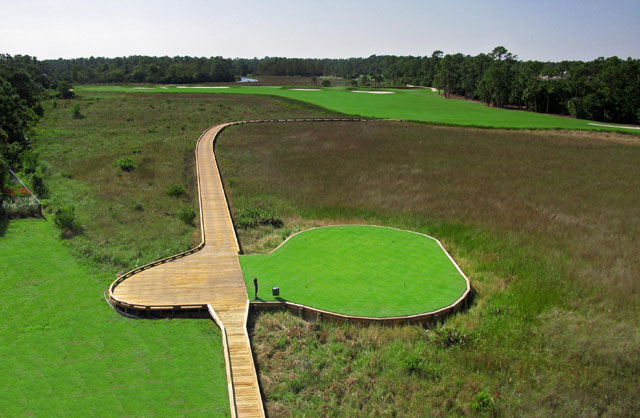 Pictured here is the 387 yard Member tees of the 15th hole at Old Marsh Golf Club. Rated the 4th hardest hole on the course, the 15th is a great dogleg left, par 4.
Pictured here is the 387 yard Member tees of the 15th hole at Old Marsh Golf Club. Rated the 4th hardest hole on the course, the 15th is a great dogleg left, par 4.

In 1986 developer Bob Whitley hired me to design the golf course at Old Marsh Golf Club in Palm Beach Gardens. The proposed site for the course was a 440-acre piece of property enclosed within 40,000 acres owned by the MacArthur Foundation. Despite the many anticipated construction problems, I knew we had discovered something very special there.
I also knew that fitting 18 holes into this environmentally protected area would be a real challenge, but the result turned out to be a spectacular golf course set in the middle of a wildlife sanctuary. As an experienced golfer, I had always known that a significant part of the enjoyment of the game often comes from the player’s awareness of the beauty of the golf course and the abundant wildlife wandering freely there. But first glance at the proposed site made me wonder whether a roaring lion might appear from deep in the high grass, since the marshland’s rich vegetation and abundant species of wildlife reminded me of Africa.

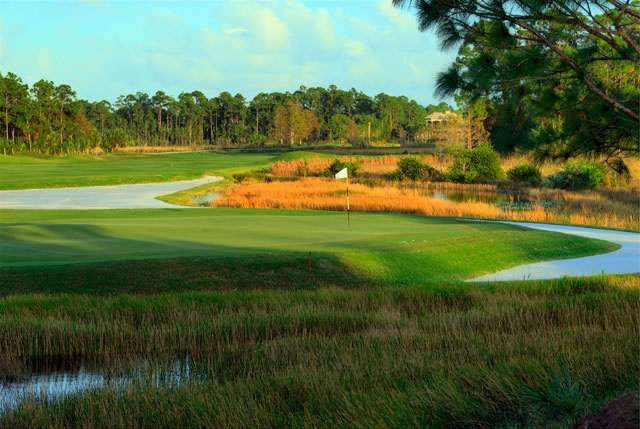
Under the regulators mitigation rules if one acre of marshland is to be utilized, the developer must create three to replace it. At Old Marsh approximately 10 acres of wetlands would be converted, so we had to come up with nearly thirty acres of manmade marshes within the boundaries of the property.
In addition, the new marshlands must be contoured in terms of depth so that the same species of wildlife that inhabited the old will inhabit the new. Deep, medium, and shallow shelves must be constructed to produce a variety of aquatic grasses.

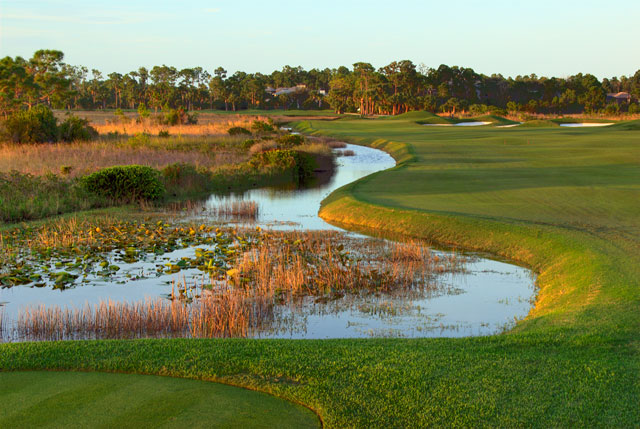
While all of the various aspects of keeping a course environmentally sound are important, I believe at Old Marsh we went beyond the call of duty by inventing a new type of recycling system. Not wanting golfers traipsing out into the marsh trampling the grasses looking for their golf balls, I designed a six-foot-wide moat at the edge of the border of the marsh. To keep golf balls from disappearing into the moat, the near edge was raised and sloped back into the fairway so a ball would have to roll uphill to drop into the water.
Having the borders of the hole tilting toward the middle of the fairway produced a bathtub effect: all the water from rain and the sprinkler system drained toward catch basins buried in the fairways. These basins connected to a ten-by-ten cement enclosed “basement,” which housed a sump pump. When the water level in this little basement triggered the float, it pumped the excess water through a six-inch line to an irrigation lake.


The water is then used to irrigate the course, and the cycle keeps repeating itself. Chemicals used to treat the fairways and roughs never enter the natural marshes because all their runoff falls into these drains that lead back to the irrigation lake.
At Old Marsh, we dug out the oblong eight-acre lake that separates holes nine and 18. Another lake was created behind the 11th green, and the dirt from these craters was spread around on the low spots of the different fairways that needed to be elevated.
The course at Old Marsh was so low profile with its greens being a little more than two feet above the water table we had to make sure to follow USGA green specifications precisely in order to provide proper drainage.

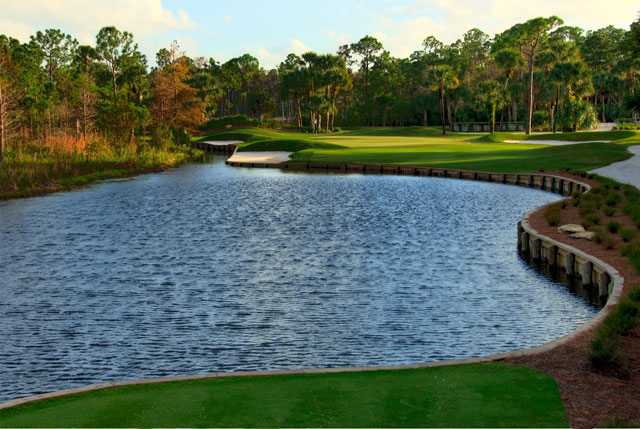
Many times an architect can actually improve the condition of land when it is modified to build a golf course. This was proven true with the comparison between the old marshes that were drained and the new ones we created to replace them. At Old Marsh, the wildlife actually preferred the new marshes to the old ones.
The three-foot-high, stately sandhill crane is most predominant there. Ibis, egrets, blue herons, great white herons, endangered wood storks, bobcats, Florida deer, and even American bald eagles also inhabit the course.
Since the native yellow-colored grasses grow fairly tall in the marshes, and the elevation level of the land is low, Old Marsh has a look even ancient courses could envy. And while I’m extremely proud of the manner in which the golf course blends in with the natural environment at Old Marsh, I believe there is also a real tempo about the course that tests and measures the players.

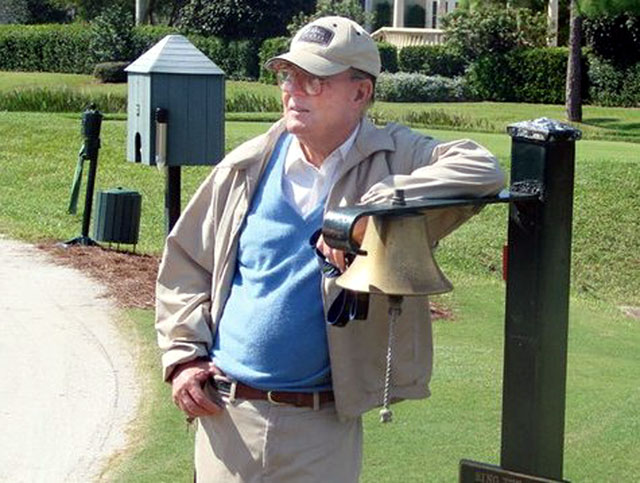 Designer, Pete Dye next to the bell behind the 5th green at Old Marsh Golf Club in Palm Beach Gardens, Florida.
Designer, Pete Dye next to the bell behind the 5th green at Old Marsh Golf Club in Palm Beach Gardens, Florida.
Old Marsh Golf Club became certified as an Audubon Cooperative Sanctuary in 1998 and the natural settings on the course are among the game’s most spectacular with some tees on islands in the marsh and flocks of snowy egrets congregating in the trees every afternoon. Old Marsh couldn’t be more ideal or special. Not only do untouchable wetlands edge the club on three sides, but 20 percent of the community’s 456 acres are marshland, so the wildlife found there is beguiling.
The course at Old Marsh will always have an extra-special meaning for me. Just behind the fifth green there is a bronze bell that is used to signal the players behind that the group in front has completed play. On the post that mounts the bell is a plaque with an inscription paying tribute to the man who taught me all I really needed to know about the game of golf. It reads, “Ring the bell for my dad, Paul F. Dye, who loved his family and everything about the game of golf.”
- Written by Pete Dye for Florida Golf Magazine

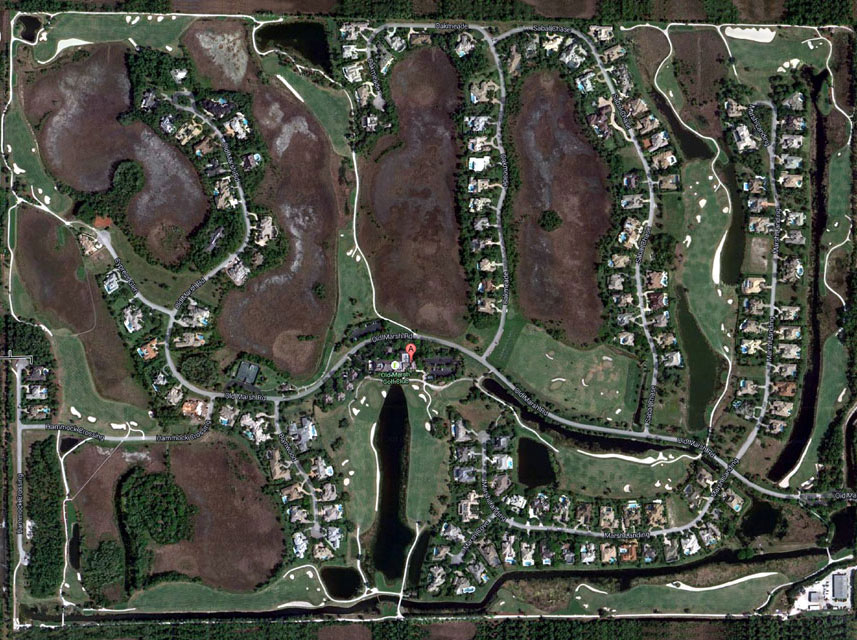 The golf course at Old Marsh Golf Club in Palm Beach Gardens, Florida, designed by Pete Dye
The golf course at Old Marsh Golf Club in Palm Beach Gardens, Florida, designed by Pete Dye

Pete Dye’s Design Notes: - Old Marsh Golf Club in Palm Beach Gardens, FloridaHole 1 - Par 4, Tour 368, Champ 363, Member 338, Mid 316, Fwd 283Hole #1 at Old Marsh Golf Club is a good opening par 4 with a wide open fairway and water along the entire left side that is guarded by a long narrow bunker. There’s also a knobby mound at the front right of the green, which partially hides the putting surface, enhancing the character of the hole. My intention was to provide putting surfaces at Old Marsh with a half-inch of fall every ten feet or so. The human eye can detect only a two-and-one-half-inch fall every ten feet, so I attempt to make a putt appear straight when it actually has some curvature. At Old Marsh the approaches to the greens are generally open in front and roll in and onto the putting surfaces, and the greens are relatively flat, with the mounds abutting. One contour on the green is also usually counteracted by another to prevent the ball from gaining speed at the hole. Hole 2 - Par 5, Tour 537, Champ 500, Member 490, Mid 449, Fwd 417After playing the right to left 1st hole, the 2nd hole sets up left to right off the tees. This is a downwind par five that runs over water to a landing area that’s plenty wide. From the members’ tees, it’s 150 yards of carry to the fairway, but for your second shot, there’s a liberal landing area to the right. Because the green runs right to left creating a double dogleg, I suggest you hit your second shot toward the right side of the fairway so the green will open up to you. The 2nd green is shaped like a little upside down saucer, with one little pot bunker on the left in front. If you play this short par 5 from the correct tees your third shot should be a short pitch shot and a good opportunity to par or even birdie. Hole 3 - Par 3, Tour 200, Champ 194, Member 170, Mid 161, Fwd 110It’s an easy walk from the 2nd green to the 3rd tee. This is a hole to make every environmentalist’s heart leap. The entire right side of this bulkheaded par three is man-made, mitigated marsh. So what looks like Mother Nature, was actually put in there by hand, carefully re-creating a natural looking wetland. Keep your tee shot left, if anything, because there’s a safe little bailout area to the left of the good-sized green blinded from the tee. Hole 4 - Par 4, Tour 401, Champ 371, Member 343, Mid 308, Fwd 287This is a relatively short par 4 but you’ve got a pretty good carry off the tee to get over the marsh. Hit your tee shot across the marsh to the right side of the fairway, even through you can see the flag and the green toward the left. There’s plenty of landing area right, and the green is receptive from that side. The giant menacing bunker left of the landing area will keep your ball in bounds in the event of a big time hook or a pull off the tee; however it’s still shallow enough to allow for a good recovery on your second shot. But be warned, the 4th green has some significant contours and is not the easiest green to putt. Hole 5 - Par 4, Tour 362, Champ 362, Member 318, Mid 287, Fwd 230After going east on the 4th hole the 5th hole turns south into the prevailing wind. A golfer could play this hole 100 times and never really figure out how to play it. I built this love/hate hole with a short approach shot to a green hidden behind a huge two story mound. Most golfers who have traveled to Prestwick in Scotland find the design reminiscent of the par four Alps hole there. Before I believed in the design of blind holes, I mentioned my dislike for them to Tommy Armour. The silver-haired Scotsman bluntly told me I knew nothing about golf, adding, “Laddie, a blind hole is blind only once to a man with a memory.” Tommy Armour believed blind shots were effective since they created anxiety in the golfers by delaying their knowing the result of their shots. I know Ben Hogan hated them, but I think they can play an important part in the mix of holes on a particular course. Players of all levels love to walk up and look around the mound, check the placement of the pin, and then try to imagine the line of flight to the green. The whole experience is topped off when they finally hit the shot and then race to the side of the mound to see where the ball landed. Blind Man’s Bluff at Old Marsh is a short par 4 that measures only 320 yards from the back tee, but there is water to the right that borders the entire hole. If the tee shot is properly positioned in the middle of the fairway, a small obelisk rock sitting on top of the mound signals the line to the green. To play this hole I suggest you hit the tee shot 120 yards short of the mound, so that you can then hit a full nine iron to the green. The wind prevails from the southeast, so the left side of the green is safe no matter where the rock is (the rock on the top of the hill gives you a line to the flag very much like the Dell hole at Ballybunion.). Get it on the green and go for two putts. But don’t use too much club, because there’s a pond beyond the 5th green. Hole 6 - Par 4, Tour 469, Champ 444, Member 418, Mid 399, Fwd 349Continuing south, we mentally shift gears from a short par 4 to a good long par 4. The #1 handicap hole on the course, the 6th hole is one of the few “brute strength” holes at Old Marsh where placement and club selection usually prevail over power. Once again, aim away from the green to the widest part of the fairway, straight at the bunker on the left. You’ll then have a wide open shot to the smallish 6th green. The long narrow bunker on the right in front of the green is more to prevent the player’s errant shot from going into the water than it is to provide another hazard. Hole 7 - Par 5, Tour 556, Champ 556, Member 540, Mid 500, Fwd 430Changing direction, Hole #7 runs westward. Since you’re faced with marsh and a long bunker on the right side of this dogleg right par 5, I suggest that you should hit your tee shot to the left side of the fairway for best results. Then, your second shot should also favor the left side of the fairway, which will provide you with the best angle to approach the green. Again, the strategy at Old Marsh is to hit the ball where the percentages are best and that’s by no means always at the green or the flag. Hole 8 - Par 3, Tour 173, Champ 155, Member 146, Mid 137, Fwd 116This is the best little downwind par three I’ve ever built. Although you’ve got to carry it over water all the way, once you get there the bulkheaded green is the size of a football field. The natural marsh on the right and the deep pine woods on the left should be enough to force your attention to the pin. When it’s set on the right, I usually aim my tee shot to the left side and cut it in over the marsh, and then putt for a birdie. Hole 9 - Par 4, Tour 458, Champ 437, Member 396, Mid 385, Fwd 315Turning back north again onto the 9th hole we have now gone all four directions. Even though it’s rated the 3rd hardest hole on the course with its bulkhead and water along the entire left side, this par 4 might be considered a relief hole from the members’ tee since it has the widest approach and fairway on the whole course. If you’re playing from the correct tee, you shouldn’t have any trouble carrying the lagoon to the generous landing area and you could very well get home in two. Now the 9th green has got some contour to it but it’s not that severe so there’s no reason you couldn’t get a par on this relatively long par 4. Hole 10 - Par 4, Tour 313, Champ 313, Member 300, Mid 271, Fwd 227After the clockwise rotation of the front side holes, those on the back run counterclockwise, with wetlands bordering the left side of most of the holes. You get a great change of pace coming from the long difficult par four 9th to the short easy par four 10th hole. Though it’s the shortest par 4 on the course, I personally like the 10th hole a lot: because it so often proves that finesse is more important than brawn in the game of golf. At just 313 yards from the very back tee, the longest hitters may be able to challenge the green off the tee, making an eagle, two. But it’s still very challenging because there is marsh on the left and right, so an accurate shot off the tee is definitely required. I would suggest that players laying up would be best served positioning their ball just left of the small pine and palm tree grove that is about 200 yards off the tee, leaving them with a short wedge approach to the green. A large bunker protects the front right side of the green and also hides the middle and right-hand side from the players view as they approach. This shot requires a precise wedge to get the ball close, but you can roll the ball onto the left side of the green, which is built to the existing grade. The green also has a lot of undulations and subtle breaks that require an accurate read in order to be able to hole your birdie or save par here at #10. Hole 11 - Par 4, Tour 399, Champ 391, Member 345, Mid 328, Fwd 278Eleven is a little bit longer par 4 that doglegs right to left and has a liberal driving area especially if you keep it to the right side. Once again, the straight line off the tee is risky as it means you have to hit over the marsh on the left. In my opinion you are better off keeping your tee shot to the right, where you’ll wind up with an open shot to the green. The 11th green itself is also pretty receptive and open in front so you can either roll it in or get the approach up in the air and carry it in. Hole 12 - Par 5, Tour 502, Champ 478, Member 465, Mid 429, Fwd 381Now for another change of pace, Hole #12 is a par five that goes dead west. It is the shortest par five on the course, and the hazards here are chiefly mental. The marshes and the feeding birds frequently will distract you from what should really be a not-that-difficult tee shot. The carry from the members’ tees is only 160 yards, and the landing area is very generous. Once there, hit your second shot to the right, short of the green. The big hitters who go for it will find a large bunker in front of the green, and disaster in the form of a marsh beyond the green. Hole 13 - Par 4, Tour 406, Champ 377, Member 366, Mid 336, Fwd 274To mix it up, #12 was a hard hole but not-so-much a difficult driving fairway, whereas #13 is an easier hole but a more difficult driving fairway. The most difficult tee shot at Old Marsh, hole #13 is a dogleg left that runs south and features marsh on the left and out of bounds on the right. When you see that flag down to the left, you’ll subconsciously want to hit it to that side of the fairway, but resist the urge. I would aim for the right-center of the fairway because there is more room on the right than is visible from the tee. Now, greenside, there’s a bunker built along the right and the green itself looks flat, but, we built the bunker up the way 19th century courses were built with “blind” parts of the greens. Thirteen is a perfect example of the semi-blind green, due to the old-style mound on the right. Hole 14 - Par 3, Tour 215, Champ 190, Member 175, Mid 152, Fwd 128Hole #14 is the longest par three on the course. There is nothing in front of the green, and to the right there is a big collar of Bermuda grass. Most often I would suggest hitting it toward the right rather than to the pin. That’s how I usually play this hole. The whole thing about Old Marsh, throughout the course, is to stay away from the marsh. If you miss it right here for example you can at least keep it in play. Miss it left, and your ball becomes part of the local ecology. This bunkerless par three is unique. I love this hole. Hole 15 - Par 4, Tour 471, Champ 393, Member 387, Mid 323, Fwd 312Rated the 4th hardest hole on the course, the 15th hole is a great dogleg left, par 4 with enough landing area on the right side for two football fields. But because the green is to the left, over the marsh, players persist in cutting off too much of the dogleg. Instead, I would play it straight down the middle of the fairway, and wind up with an open shot to the green. From mid-fairway, you’ll have a medium iron to the contoured green. If the hole placement is to the rear, make sure you take an extra club. Hole 16 - Par 3, Tour 176, Champ 176, Member 162, Mid 145, Fwd 124I don’t know why, but the 16th hole is rated as the easiest hole on the course. This par three, over water, is the tightest bunkered green on the course. There’s no bailout area, but the green is quite large. Although the bunkers don’t blind the green, some of the contours can fool you. I will tell you this however; a good iron off the tee will be rewarded on this green. Hole 17 - Par 5, Tour 573, Champ 530, Member 510, Mid 468, Fwd 401Rated as the 2nd hardest hole on the course, this long par 5 with water on both sides, has plenty of room on the left side, so aim your tee shot to the left. On the canal side of the fairway you notice a distinctive feature that we maintain throughout the course at Old Marsh where the grass along the banks of the marsh are maintained at a much taller height of cut in order to add stability to the bank. But also as a design feature, it makes the holes play a little easier by preventing the players’ ball from going down in the hazard. Your second shot on this hole should be a positioned iron shot, aimed towards the right center of the green. There’s really no reason to gamble here, since unless you hit it as far as a touring pro, you can’t get home anyway. Whatever you do, don’t go left with your second shot, or your ball will become the property of the resident pair of Sandhill Cranes who live there. By the way, their names are Pete and Alice. Hole 18 - Par 4, Tour 460, Champ 440, Member 395, Mid 376, Fwd 316The final hole plays downwind, and is a mirror twin of nine. This one plays from left to right, and the member player has the widest landing area. Keep it left, away from the lake. With the sight of the Old Marsh Clubhouse in the background, you can roll it on from the front left from where the contours make it most receptive. But be warned, it takes an accurate read to hole out on the huge 18th green. |



